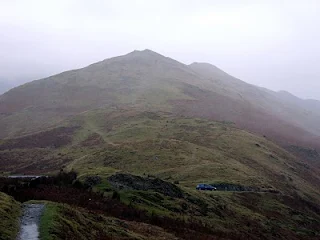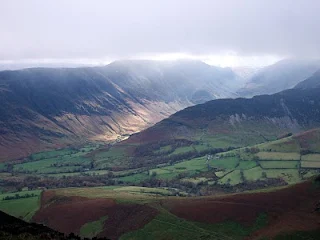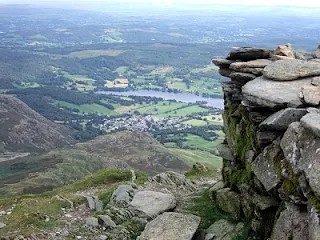
Along the eastern boundaries of Lakeland between the high fells and the Shap road there lies a remote hill country that sees few visitors compared to the better known areas to the West. Only peak baggers and walkers who like solitude would recognise the names of Tarn Crag, Harrop Pike and Grey Crag but while the region may lack the spectacular scenery of Wasdale Head and the Buttermere valley, it does have a charm of its own.
The only road to venture up here is the 5 mile single track lane to Sadgill at the head of Longsleddale; itself reached from the A6 just north of Kendal and it is from Sadgill that this walk starts and finishes. For the Wainwright bagger the tally is 5 - the first 2 of which I had not previously done myself - and the walk is effectively a horseshoe around the head of Longsleddale lasting ten and a half miles that sets off through the lonely country to the East of the valley and finishes on the more familiar ridge of Harter Fell and Kentmere Pike to the West.
The parking area is at the road end just before the bridge - I don't know of a bus up here - and the route begins through the gate on its eastern side. Please take care not to block the gates or track as space is limited especially at weekends. There is no clear path on the other side of the wall but make for the gap in the wall that is visible above and to the left.
Beyond the second wall a faint path climbed the steep fellside ahead skirting around to the right of the rocky outcrop above and ascending a shallow gully. At the top of this the gradient eased and there was soon a third wall across my path but with no gap. Here I followed the path to the right alongside the stone wall until an opportunity arose for climbing it - which I duly did. I needn't have done so because a little further on a stile crosses it in any case.
From the stile a path leads up the hill on the far side of the wall - where it is unclear keep left towards the highest ground which is known as Great How. From here an obvious track makes its way across the undulating terrain ahead. The first summit - Grey Crag - is ahead and slightly to the right and the path does make its way in this direction in front of the peak before turning back left to the summit. This avoids some steep rough ground that a beeline would cross.
The summit of Grey Crag - the easternmost of the Wainwrights - is an isolated spot as one could find in the Lake District and I was not surprised to have it to myself. Even the sheep were elsewhere. Mist hid the fells to the West and the most eye catching view was that of the Howgills to the South East.
The way to Tarn Crag is a case of following the faint path from here towards where a fence is seen on the far side of the summit. A distant stone pillar was visible to the east across a 2000 foot high plateau of tussock country that seemed to mark the true edge of the high country so I diverted towards it. The cairn is on nearby Harrop Pike about half a mile diversion eastwards from the fence and it provides extensive views over the Shap Fells and the Pennines. If you were trekking cross country to the Shap Road (A6) this is the way you would come.
A note for peak baggers; Harrop Pike is not a Wainwright but is a two thousander just in case the decision to visit it rests with such things, but it's an easy walk that adds less than a mile to the route today and on a warm sunny day it would make a great lunch stop.
Returning to the fence it was just a case of following the path north down into a marshy gap then back up a gradual climb to Tarn Crag where there was no view. A stone tower adorns this fell too - just to the west of the highest point but it's a much more substantial construction than the cairn on Harrop Pike.
There are crags to the West of Tarn Crag's summit so to access the Gatescarth Pass track we must head north again. In the end because of the visibility I followed the clear path all the way to the col with Branstree instead of looking for the short cut down along a stream. There was no path that way in any case. I soon picked up the track from Mosedale and followed it down to the bridleway.
When the Gatescarth route is met we turn right and follow the wide track steeply up to the top of the pass where - just after a gate - another obvious path branches left to ascend Harter Fell. Carrying on will take you down to Mardale and Haweswater.
I followed the wide route up towards Harter Fell. There had been a metre of snow the last time I was up here which is probably why I didn't remember the path being like this. I followed it to the top where - yes there was no view again. That's a shame because the view of Haweswater from Harter Fell is just superb - the best place is an area of rocks to the right of the path just before the first summit is reached. The true summit is almost another half a mile after this. There was no view there either.
Now I was on the way back - and it was nearly all downhill from here. An obvious path leads south then south east to make the small climb to Kentmere Pike before continuing down the gentle slope to Shipman Knotts. The higher ground to the left of the path between these 2 fells is the top of Goat Scar and is well worth a visit - in better visibility - for the views of Longsleddale.
After Shipman Knotts the terrain changes again and the descent becomes steeper and rockier than the route so far. The path descends beside a wall then crosses a marshy plateau before making a steep descent towards the Sadgill-Kentmere bridleway. It isn't quite a scramble but as close as this route gets. When the bridleway is reached we turn left back to Sadgill which is not far - less than a mile downhill.
Pete Buckley Mar 2011
Summits: Grey Crag 638m >>> Harrop Pike 637m >>> Tarn Crag 664m >>> Harter Fell 778m >>> Kentmere Pike 730m >>> Shipman Knotts 587m
Essentials >>> Up 950m >>> down 950m >>> How Far? 17km >>> Start and finish at Sadgill Longsleddale >>> more walks and hikes






